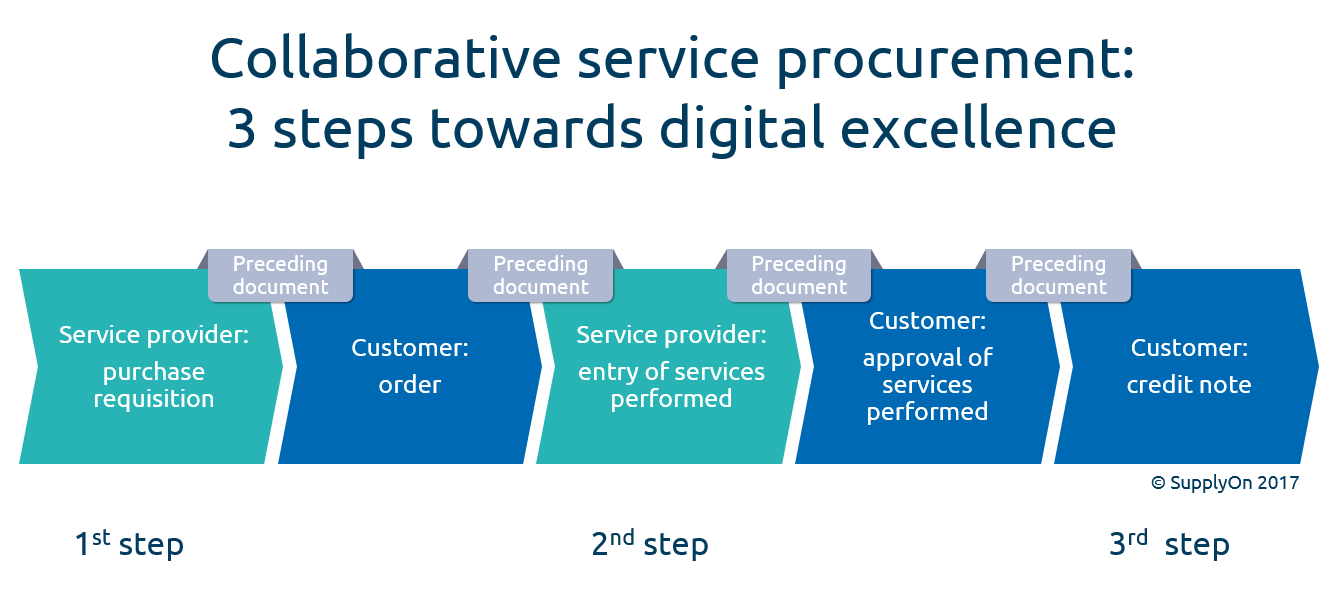Three steps to digital service procurement

At many companies, the procurement of services – either on the basis of an e-catalog or via a free-text order – is still characterized by many inconsistencies. Internal ERP systems often support demand analysis and the approval process by the manager who oversees the budget in the SRM system. But there is often a discrepancy between the content of the order request from what should actually be ordered. In practice, the offer is often sent to the requisitioner by the service provider in an e-mail message or as a paper document – and then not included in the order request. Why does this happen? Because adding all the individual items from the offer to the order request involves a lot of work for the requisitioner. And he tries to avoid this effort.
What does this mean for the process? The approval of the order request produces a corresponding budget item in the ERP for the booking of the invoice. But the order itself is still sent out by fax, e-mail or even by postal mail. The actual entry of the services performed is generally likewise handled completely on paper. The requisitioner and the provider reach an oral agreement if the amount exceeds or falls below the defined budget. So by the time the invoice reaches the finance department, the information on the invoice frequently has little in common with the information on the order, much less the offer. As a result, the internal auditors have to piece together every line of activity and determine which services were actually authorized for payment – or not. This is definitely not a value-creating process.
Service procurement: digital from the start
What’s the solution to this problem? It’s really quite simple: The procurement of services must be digitalized end-to-end – from the demand analysis through to invoicing. As a rule, the following three steps should be taken:

1. Let the service provider fill out the order request
No one understands the order better than the service provider. Why not let him or her prepare the offer online? SupplyOn makes this possible. The offer submitted to the platform is transmitted via an interface to the customer’s ERP system, which ensures that the order request contains all relevant items. In turn, the order is generated in the ERP based on the exact order request which has been approved and is then available to the service provider in digital form.
2. Let the service provider enter the services performed
Service providers normally provide proof of performance as the basis for their invoices, which must then be approved. You can additionally let the service provider prepare this documentation on the digital order. In this process, you can even decide whether the provider should be allowed to “oversupply”. That is, overbook order items or even add new ones. The requisitioner at your company can review the entry of services directly in the system and approve it. Or he can get subsequent approval for possible additional costs by a supervisor.
3. Invoice check? Switch to the self-billing invoice
If you use this approach, checking the invoice becomes very simple or even superfluous – much more so than with solutions that involve invoice scanning. The supplier can conveniently convert the list of services prepared by the provider and approved by the requisitioner into an invoice that he or she can send via interface to your ERP. As an alternative, a self-billing invoice for the service provider can be produced on the basis of the approved entry of services from your ERP system.
Only an integrated end-to-end process for the procurement of services facilitates transparency and eliminates activities that are unnecessary or don’t generate added value.
The benefits are obvious: The order request approval, the order itself, the provision and entry of services and the invoicing of services are handled in a completely integrated and digitalized process. Recurrences and non-productive clarification by e-mail or telephone are eliminated and parallel processes are prevented. Transparency and traceability increase significantly. Aside from that, your company’s auditors will be happy to learn that the procurement process is implemented seamlessly and that all compliance rules are upheld. In comparison, the practice of scanning invoices can offer only a fraction of this potential.
Everyone pulls together
The next challenge is to ensure that optimization isn’t limited to the work of the departments involved in service procurement (such as the invoice checks handled by scanning invoices). SupplyOn offers all of the technical prerequisites needed to digitally map the optimization of the entire purchase-to-pay process – completely integrated in your company’s ERP system. And naturally you can use any savings for all the other material groups in the procurement of non-production material (indirect procurement).
Everyone benefits from really good solutions
In addition to all of the benefits enjoyed by your company, there is one big payoff for service providers: They get their money faster.



